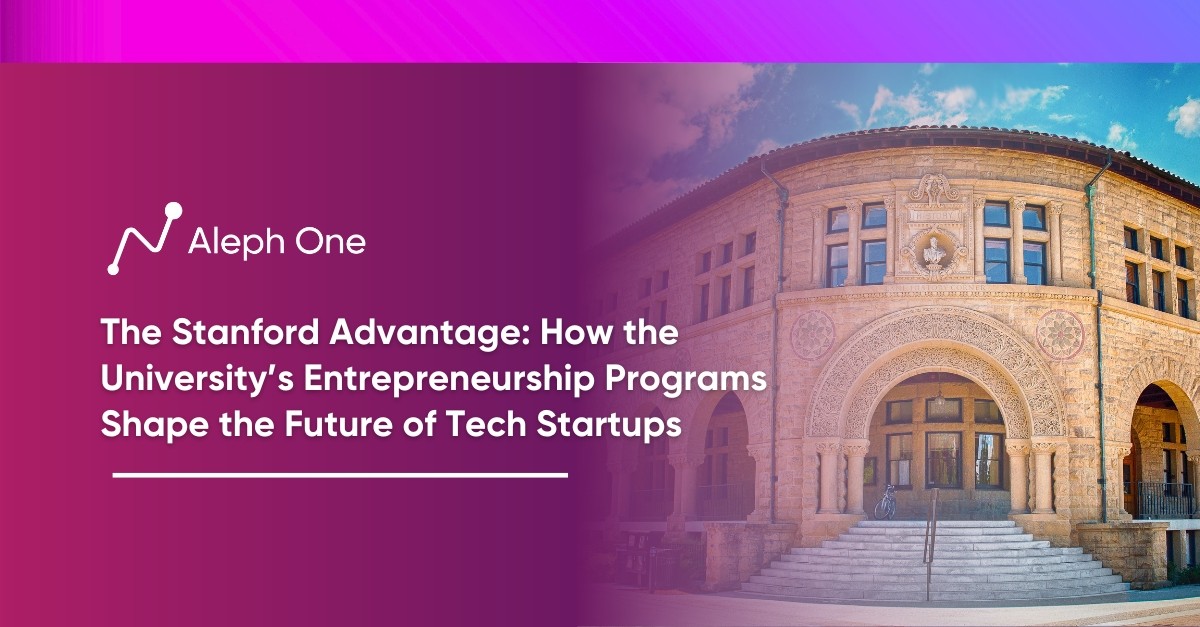Let’s work together to build something amazing. Share your project details and our team will reply to figure out the next steps to your success.

In the heart of California’s Silicon Valley lies a university that has been instrumental in shaping modern technology and innovation. Since the 1950s, Stanford University has been cultivating a culture of entrepreneurship that continues to define the spirit of the tech startup world. Under the visionary leadership of Frederick Terman, the Dean of Engineering, from 1955 to 1965, Stanford pioneered a movement that led to the rise of Silicon Valley as a global hub for innovation. Terman’s bold initiatives, including fostering partnerships with industry giants and encouraging cross-disciplinary collaborations, catalyzed the birth of countless tech giants. This article delves into the remarkable legacy of innovation that Stanford has forged, tracing its roots from Terman’s visionary leadership to the thriving entrepreneurial ecosystem that continues to flourish on campus today.

A Legacy of Innovation: How Stanford Pioneered the Silicon Valley Spirit
Stanford University has been cultivating an entrepreneurial spirit since the 1950s. Under the leadership of Frederick Terman, Stanford’s Dean of Engineering, from 1955 to 1965, the university actively encouraged faculty and students to collaborate with industry and promote knowledge transfer. Terman nurtured partnerships between Stanford engineers and local tech companies, leading to the rise of Silicon Valley as America’s startup and technology hub.
Forging Collaborations with Industry Giants
In the 1950s, Terman fostered collaborations between Stanford and industry leaders like Hewlett-Packard, Varian Associates, and Eastman Kodak. He created programs for faculty to take leaves of absence to work with companies and for students to intern with tech firms. This open flow of people and ideas between Stanford and the private sector catalyzed innovation. By the 1960s, many of Terman’s students had founded companies, including tech giants like Cisco, Yahoo, and Sun Microsystems.
Cultivating the Silicon Valley Ecosystem
Terman transformed Silicon Valley into a fertile ground for tech entrepreneurship. He recognized that Stanford’s intellectual capital and talent could propel the local tech industry. Under his leadership, Stanford embraced its role as a catalyst for economic and technological development in the region. The collaborative partnerships Terman forged set the template for today’s close-knit Silicon Valley community, where entrepreneurs, investors, and researchers freely share ideas and talent.
The Enduring Spirit of Entrepreneurship
Stanford’s entrepreneurial culture, rooted in openness to new ideas and partnerships, has endured and strengthened over the decades. Successive university presidents and deans have expanded programs to translate Stanford discoveries into real-world impact. Private-sector collaborations are deeply ingrained in Stanford’s DNA across all disciplines. This entrepreneurial spirit continues to attract and shape generations of innovators, risk-takers, and startup founders. Through its pioneering programs and culture, Stanford has defined the model for entrepreneurial education and created a legacy of innovation that drives Silicon Valley.
The Stanford Advantage: An Entrepreneurial Education Like No Other
Stanford offers unparalleled entrepreneurship education across its schools and programs. At the Stanford Graduate School of Business (GSB), students can pursue a Leadership and Entrepreneurial Thinking (LEAD) certificate to build startups. The GSB also offers popular electives like “Entrepreneurship: Formation of New Ventures,” where students create business plans.
Stanford Engineering’s Entrepreneurship Pathways
Stanford Engineering provides hands-on entrepreneurship opportunities through the Stanford Ignite and StartX accelerators. At Ignite, students take a full-quarter course to develop startup ideas, then spend the summer building companies. “We get to work on our startup dreams with talented peers and mentors,” says electrical engineering student and Ignite founder Annie Chen. “The program teaches us to get out of the classroom and solve real-world problems.”
StartX: Bridging Graduation to Startup Success
StartX supports Stanford-affiliated startups beyond graduation. “StartX introduced us to mentors and investors and helped us grow our medical device startup,” says bioengineering PhD and StartX founder Divya Nag. “The Stanford network and brand opened many doors.”
The Power of Cross-School Collaboration
Cross-school programs blend business and tech skills. In the “Building a Startup” course, GSB and Engineering students team up to launch companies. “Teaming with business students taught me the value of sales and marketing, not just product development,” says computer science student and course founder Ryan Lee.
Stanford Programs as Recruitment Grounds
Venture capital firms and Silicon Valley companies actively recruit from Stanford’s entrepreneurship programs. “These programs gave me the courage and skills to start my own company,” says GSB alum Elaine Chen, who founded a tech-enabled beauty startup. “My Stanford education continues to open doors years later.”
The Stanford Advantage in Shaping Innovators
From dorm rooms to boardrooms, Stanford nurtures entrepreneurs through a network of courses, programs, mentors, and experiences that teach students to take risks, nurture ideas and launch world-changing companies. The Stanford advantage shapes students into innovators and future tech leaders.
From Dorm Room to Boardroom: Stanford Success Stories
Stanford’s entrepreneurial culture has birthed some of the world’s most impactful startups, launched from student dorms. Google, founded by Ph.D. students Larry Page and Sergey Brin, epitomizes the Stanford startup fairytale. In 1996, Page and Brin built a search engine in their dorm rooms. Today, Google powers over 3.5 billion searches per day and has a market cap of over $1 trillion.
Snapchat and Netflix
Snapchat, the popular messaging app, is another Stanford startup success. CEO Evan Spiegel created the idea for Snapchat as a Stanford student in 2011. Now Snapchat has over 200 million daily active users and a valuation of $33 billion. Netflix, the streaming media giant, was also founded by Stanford alumni Reed Hastings and Marc Randolph. Hastings came up with the Netflix concept after being charged $40 in late fees for returning a rental copy of Apollo 13 late. Today, Netflix has over 167 million subscribers worldwide and a market cap of $230 billion.
Stanford’s Track Record
These startups are just a glimpse into the immense entrepreneurial impact of Stanford. According to Pitchbook data, Stanford alumni and students have raised over $27.8 billion in company funding since 2006. Stanford ranks first in the world for producing “unicorn” startups or private companies valued at over $1 billion. It has birthed over 60 unicorns, including DoorDash, Instacart, and Coinbase.
Cultivating a Culture of Startup Brilliance
Stanford’s startup success is no coincidence. The university’s entrepreneurial ecosystem, risk-taking culture, and emphasis on interdisciplinary thinking prime students to identify and solve real-world problems. Stanford also encourages students to pursue seemingly outlandish ideas that can turn into billion-dollar companies. Thanks to Stanford’s entrepreneurial spirit, the world’s next wave of innovative startups is brewing in its dorm rooms, labs, and classrooms. The startup stars of tomorrow are walking through the Quad today, dreaming of how they might change the world.
Failure 101: Why Stanford’s Entrepreneurship Programs Embrace Failure
Stanford’s entrepreneurship programs recognize that failure is inevitable in creating something new. Instead of punishing failure, they view it as a valuable learning opportunity. “We teach students that failure is not the opposite of success, but rather an integral part of success,” says Tom Byers, faculty co-director of the Stanford Technology Ventures Program.
Cultivating Resilience
Many Stanford courses require students to launch a startup or product, knowing some will stumble. For example, in ME310 Global Entrepreneurial Marketing, students must develop and pitch a new product in an unfamiliar global market. “Pushing students into uncomfortable situations where failure is likely helps them build resilience,” says instructor Mark Leslie. His students have failed to gain customer traction, run out of funding, and faced unforeseen challenges in foreign markets. Yet through failure, they developed skills that can only be achieved through experience.
Failure Fuels Innovation
Some of Stanford’s most innovative student startups were born out of failure. After a frustrating internship experience, Jared Smith ’19 launched Intern Atlas to help students find high-quality internships. The startup failed to gain traction, but Smith applied lessons from the background to launch Campus, a student-focused navigation app, which raised $8 million in funding. “Failure in my first startup made me a better entrepreneur,” says Smith. “Stanford’s entrepreneurship programs gave me the support system to fail fast and try again.”
Learning from Setbacks
To fully embed the lessons of failure, some Stanford courses require students to fail and start over. In the Design for Extreme Affordability course, student teams design products for the developing world. The teams then travel to rural India or Kenya to test their prototypes, often failing in the field. “Failure in the real world is the only way students can learn the true challenges of innovation,” says course co-founder Jim Patell. “By embracing failure, students build up their resilience and become better innovators.”
Entrepreneurial Failure is Always an Option
Through trial and error, Stanford’s entrepreneurship programs teach students that failure is not the end but rather the beginning. By normalizing and learning from failure, Stanford students develop the perseverance and growth mindset to succeed as entrepreneurs in the face of uncertainty. Failure may be the ultimate teacher, and entrepreneurial failure is always an option at Stanford.
The Road Ahead: How Stanford Continues to Drive Innovation
Stanford shows no signs of slowing down its entrepreneurial momentum. New programs like the Stanford Graduate School of Business’s Innovation and Entrepreneurship major will continue to empower students to design innovative solutions to global problems. “The major reflects how entrepreneurship and innovation have become fundamental skills for leadership in the 21st century,” says GSB Dean Jonathan Levin.
Focusing on Emerging Startup Horizons
Stanford is also steering students toward startups in emerging areas like sustainability, healthcare, and education. The Stanford Energy Club and the GSB’s Energy Innovation and Emerging Technologies major focus on clean energy and green technology. Healthcare startups can access support from the Clinical Excellence Research Center and Biodesign programs. The Stanford d.school’s K12 Lab cultivates design thinking for education entrepreneurs.
Nurturing Startup Synergy
Stanford launched the Stanford Venture Studio in 2019 to further strengthen its startup community. It provides workspaces and resources for students to collaborate on startups as part of the university’s mission to foster interdisciplinary partnerships. “Great innovations happen when people from diverse fields come together to solve important problems,” says Tom Byers, faculty co-director of the Stanford Venture Studio.
A Collaborative Edge
Partnerships with Silicon Valley tech companies also keep Stanford at the cutting edge of innovation. Recently, Stanford partnered with NVIDIA to launch an AI Lab that applied artificial intelligence to healthcare, transportation, and education fields. The lab will also incubate startups using AI to drive social impact.
Stanford’s Legacy of Openness
Stanford’s culture of openness, experimentation, and risk-taking has unleashed over 70 years of entrepreneurial spirit with no signs of slowing. “Stanford will continue to empower young people to solve problems and take risks,” says Byers. The university stays dedicated to nurturing new generations of entrepreneurs shaping the future. Stanford remains the ideal place for aspiring innovators to start a journey that could change the world.
FAQ
How does Stanford University foster a strong entrepreneurial spirit among its students and faculty across various disciplines?
Stanford University fosters a strong entrepreneurial spirit by offering a range of entrepreneurship programs, courses, and accelerators like Stanford Ignite, StartX, and Leadership and Entrepreneurial Thinking (LEAD). These programs give students the skills, experiences, and connections they need to design and launch innovative ventures. Additionally, Stanford promotes interdisciplinary thinking, openness to new ideas, and active collaborations with industry partners.
Can you provide examples of successful startups that were born from Stanford's entrepreneurial ecosystem and how they have impacted the world?
Some successful startups born from Stanford’s entrepreneurial ecosystem include Google, Snapchat, and Netflix. Google, founded by Ph.D. students Larry Page and Sergey Brin, now powers over 3.5 billion daily searches, with a market cap of over $1 trillion. A popular messaging app, Snapchat has over 200 million daily active users and a $33 billion valuation. Both Stanford alumni Reed Hastings and Marc Randolph founded Netflix, a streaming media giant worth $230 billion with over 167 million subscribers worldwide.
How do Stanford's entrepreneurship programs embrace failure as a learning opportunity, and how does this support system encourage students to become better innovators and entrepreneurs?
Stanford’s entrepreneurship programs view failure as an integral part of success, providing students with valuable learning opportunities instead of punishing them. Many courses require students to launch a startup or product, knowing that some will face challenges or fail. Lessons learned from these experiences help students build resilience and adapt their strategies for future success. By normalizing and learning from failure, Stanford students develop the perseverance and growth mindset necessary to thrive as entrepreneurs in the face of uncertainty.
Get the latest news and updates from Aleph One in your inbox.



